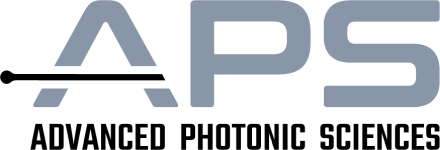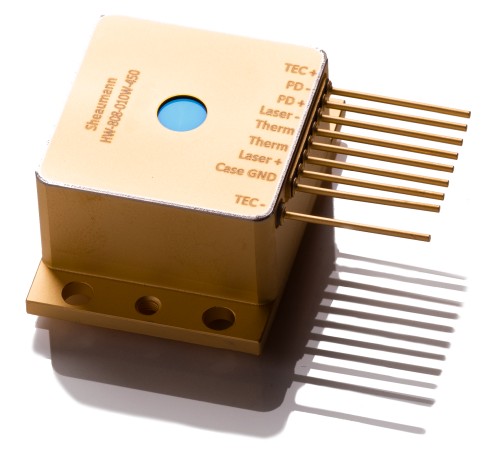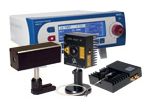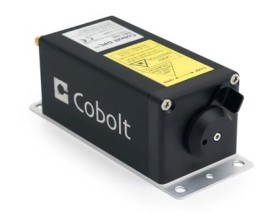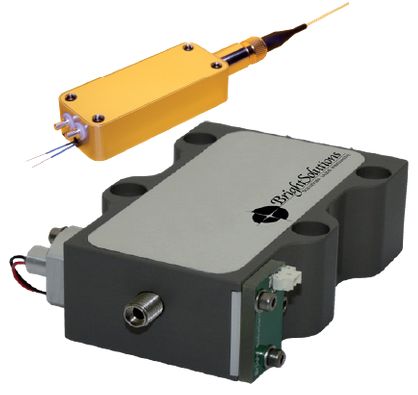laser diode modules (original) (raw)
Definition: modules containing diode lasers, and possibly also some optics, cooling devices, electrical elements, etc.
Categories:  photonic devices,
photonic devices,  laser devices and laser physics
laser devices and laser physics
- semiconductor lasers
- diode lasers
* high-brightness laser diodes
* diode bars
* diode stacks
* vertical cavity surface-emitting lasers
* external-cavity diode lasers
* fiber-coupled diode lasers
* mode-locked diode lasers
* laser diode modules
* direct diode lasers
* (more topics)
- diode lasers
Related: laser diodeslaser pointersfiber-coupled diode lasersOEM laser modules
Page views in 12 months: 607
DOI: 10.61835/kmv Cite the article: BibTex BibLaTex plain textHTML Link to this page! LinkedIn
Content quality and neutrality are maintained according to our editorial policy.
📦 For purchasing laser diode modules, use the RP Photonics Buyer's Guide — an expert-curated directory for finding all relevant suppliers, which also offers advanced purchasing assistance.
Contents
What are Laser Diode Modules?
Laser diodes are often used in the form of laser diode modules, i.e. packages which contain one or several laser diodes, in most cases combined with some optics and electronics. Such modules are much easier to use than bare laser diodes, as they serve a number of functions, as explained in the following. The optical output is either into free space — typically as a collimated beam, through a connected fiber or with a fiber connector.
Beam Shaping
For a laser diode module with free-space output, some optics (e.g. consisting of collimating lenses, micro-optics, and anamorphic prism pairs) can be used to shape the output beam, e.g. to obtain an approximately circular (or sometimes elliptical) beam with small divergence. Such a collimated beam can be more easily transmitted over some distance and more efficiently coupled to an optical fiber.
Important parameters e.g. for collimated outputs are the beam radius and beam divergence angle in both directions, the beam quality factor ($M^2$) and some measure for the beam pointing fluctuations (or the possible beam direction change during the warm-up time).
Other modules for specialized applications offer certain beam shapes, e.g. that of a line, a cross, an open circle, or a square.
Fiber Coupling
Some laser diode modules are fiber-coupled, i.e., directly launch the generated light into an optical fiber (“pig-tailed” laser diodes). For limited optical power, this may be a single-mode-fiber, which might even be polarization-maintaining, as the output is often linearly polarized. Otherwise, multimode fibers are common, and are the only option at high power levels.
Power and Wavelength Stabilization
The output power may be stabilized with an internal feedback loop with a monitor photodiode (often built into the actual laser diode). Some modules are very carefully stabilized to achieve a small relative intensity noise.
There are wavelength-stabilized modules, e.g. using passive stabilization with frequency-filtered optical feedback, or just temperature stabilization (see below). The output wavelength may drift somewhat more during the warm-up time after switching on the module.
Power Modulation
In some cases, the built-in electronics have an input for power modulation. Others are meant for continuous-wave operation with constant power only.
Pulse Generation
It is possible to obtain nanosecond or even picosecond light pulses from laser diode modules. For example, there are gain-switched modules with integrated driver electronics — which is important as very short electrical connections should be used for that mode of operation. In other cases, one uses quasi-continuous-wave operation with much longer pulse durations.
Wavelength Conversion
There are green-emitting laser diode modules containing a tiny diode-pumped solid-state laser (often a Nd:YVO4 laser) and an internal frequency doubler. Such a module may contain an amplified single-mode laser diode and a nonlinear waveguide, for example.
Electrical Connections
A laser diode module may contain not only simple connections to the pins of the laser diode, but also additional electronic circuits, e.g. for protecting the laser diode against electrostatic discharge (ESD protection), wrong polarity and too high operating voltages. Power stabilization (see above) and/or power monitoring is another possibility, also electronics for gain switching.
A module can often be operated directly with a battery or with an unstabilized power supply.
The module case may also provide effective shielding against external electromagnetic influences, which might otherwise affect the drive current and output power.
Cooling and Temperature Stabilization
For high powers, a laser diode module can facilitate the cooling, e.g. by offering a metallic surface which can easily be mounted on a cooler.
Temperature stabilization is also important for low-power diode modules, since the junction temperature influences the emission wavelength. A thermoelectric cooler (TEC) may also be included, often with a feedback system to stabilize the diode temperature. This leads to a more stable output wavelength and output power.
Applications
Applications of laser diode modules include precise pointing and alignment of optical elements, printing and imaging systems, displays, bar code scanning, optical data storage, optical sensors, pumping of solid-state lasers, free-space optical communications, and medical applications (e.g. photodynamic therapy, ophthalmology).
Many modules are used as OEM laser modules, i.e., integrated into larger devices by a manufacturer who does not want to deal with various details of the laser diodes.
There are also laser pointers, which can be considered as laser diode modules with integrated batteries, normally used as hand-held devices.
Frequently Asked Questions
What is a laser diode module?
A laser diode module is a package containing one or more laser diodes, typically combined with optics for beam shaping and electronics for power control and protection. This makes it much easier to use than a bare laser diode.
Why do laser diode modules contain optics?
Optics are used to shape the laser beam, for example, to create a collimated beam with low divergence or to focus it into an optical fiber. They can also create specific beam shapes like a line or a cross for specialized applications.
What are fiber-coupled laser diode modules?
These are modules where the laser light is directly launched into an attached optical fiber, making them 'pig-tailed' laser diodes. The fiber can be single-mode for lower powers or multimode for high-power applications.
How is the output of a laser diode module stabilized?
The output power can be stabilized using a feedback loop with an internal monitor photodiode. The emission wavelength is often stabilized by precisely controlling the laser diode's temperature, for instance with an integrated thermoelectric cooler (TEC).
Can laser diode modules produce short light pulses?
Yes, some modules are designed to generate nanosecond or even picosecond pulses, for example through gain switching. These often include integrated driver electronics for optimal performance, as short electrical connections are crucial.
What is an OEM laser module?
An OEM (Original Equipment Manufacturer) laser module is a component designed to be integrated into a larger device by a manufacturer who prefers not to handle the complexities of bare laser diodes.
Suppliers
Sponsored content: The RP Photonics Buyer's Guide contains 111 suppliers for laser diode modules. Among them:
⚙ hardware
APS’ new Cool Photons Module is a robust water-cooled assembly that allows easy setup and operation of high-power laser diodes, while also providing cooling and temperature monitoring. Compatible diodes can be found on APS website under high power visible laser diodes.
⚙ hardware
Sheaumann Laser offers various kinds of diode laser modules. The SheauPac Signature Package with its proprietary design withstands extreme temperature and vibration conditions as often encountered in military, industrial and space applications. The 2-pin package lasers have hermetically sealed fiber-coupled packages. There are also various butterfly (7-pin and 14-pin) packages available, and our High Heat Load (HHL) packages.
⚙ hardware
Serving North America, RPMC Lasers offers laser diode modules in every color—UV, violet, blue, green, red, NIR, SWIR, MWIR, and LWIR—with single/multimode, narrow linewidth, wavelength-stabilized, and ultra-compact or research-grade combiner options for any application.
Compact and user-friendly, these all-in-one modules feature integrated thermal management and electrical interfaces, delivering rugged, easy-to-use designs, including field-portable USB-powered units for advanced lab use.
Configurable and customizable, they range from milliwatts to several watts, with high-power, low-noise, OEM, or plug-and-play setups, plus free-space or fiber-coupled outputs and optional add-ons tailored to your specific needs.
Let RPMC help you find the right laser diode module today!
⚙ hardware
QPC Lasers manufactures fiber-coupled diode laser modules with the highest powers and brightness in the industry at wavelengths ranging from 780 to 2000 nm.
Products range from sub-watt single-mode PM fiber coupled diodes for LIDAR and communications to multi-mode fiber-coupled modules with outputs in the hundreds of watts for medical, materials processing and pumping applications. Optional features include Brightlock monolithically spectrally stabilized diodes for unmatched linewidth and spectral control.
⚙ hardware
CNI has developed compact laser diode modules with spot, line, cross or fiber-coupled output. Typical features are small size, high compatibility, cost-effectiveness and easy integration into instruments and OEM equipments. Many output wavelengths are offered.
⚙ hardware
Monocrom has developed extended lifetime diode-based lasers for dermatology and aesthetics applications with different levels of integration, from laser stacks up to plug & play modules. We provide also electronics and optics for laser dermatology giving the option of fiber coupling, too. Our company exclusive, solder-free laser bar Clamping™ technique ensures the optimal treatment of laser bars, obtaining high power efficiency and extended lifetime.
Monocrom is an OEM manufacturer. but also offering standard products in short lead time. We adapt to customers needs with a high degree of flexibility and versatility for their developments.
We cover other applications not mentioned here. Tell us about your medical application, and we will provide the right laser technology for it.
⚙ hardware
Osela specializes in creating custom laser diode modules tailored for OEM integration. Our expertise lies in developing application-specific solutions that seamlessly fit into your existing or new systems. These modules feature advanced thermal management, precise current control, and customizable optics to meet exacting performance requirements. Whether you need a unique wavelength, specialized beam profile, or compact form factor, our engineering team works closely with OEMs to design and manufacture laser diode modules that optimize your product's capabilities. From prototype to high-volume production, Osela ensures consistent quality and performance to support your innovative applications in machine vision, biomedical instrumentation, and industrial automation.
Related products: STREAMLINE LASER | COMPACT LASER | INDUSTRIAL LASER SYSTEM | FIRELINE LASER | TELECENTRIC LASER PROJECTOR | MULTI-LINE PATTERN
⚙ hardware
Sacher Lasertechnik offers industrial laser diode modules together with computer-controlled laser drivers. Emission wavelengths between 375 nm and 2800 nm are possible.
⚙ hardware
HÜBNER Photonics specializes in high-performance diode laser modules designed for applications requiring rapid power modulation and precision. Key features of our modules include:
- Fully integrated electronics for quick power adjustments with a rise time of less than 2.5 ns.
- Emission wavelengths ranging from 375 nm to 975 nm.
- Available with free-space or fiber-coupled outputs.
- Output power options from 50 mW to 400 mW.
For more detailed specifications and potential applications, please visit our website.
⚙ hardware
SHIPS TODAY: AeroDIODE offers fiber-coupled laser diodes as turn-key modules emitting between 520 nm and 1650 nm as stock items or associated with a CW or pulsed laser diode driver. They are compatible with our high speed nanosecond pulsed drivers or high power CW drivers with air cooling for the multimode high power laser diode versions.
The single mode laser diodes (either Fabry–Pérot or DFB laser diode) can reach high power in nanosecond pulse regime up to 500 mW. These turn-key diode & driver solutions are optimized for single-shot to CW performances with pulse width lengths down to 1 ns. The laser diode precision pulses are generated internally by an on-board pulse generator, or on demand from an external TTL signal. Many multimode versions are available with CW emission up to 300 W in a 200-µm core multimode fiber or up to 250 W in a 135-µm core fiber or 160 W in a 105 µm core fiber.
See also our tutorial on fiber-coupled laser diodes.
⚙ hardware
Bright Solutions offers the BDL and BFD — fiber-coupled diode laser modules:
- up to 200 W cw (or 400 W quasi-cw) in a 200-μm core fiber
- flat top beam profile
- integrated TE cooler, current and temperature controller
- optional fiber sensor
- pulsed models are available
They are used e.g. for pumping of solid-state and fiber lasers, material processing or illumination.
⚙ hardware
CSRayzer offers a wide range of diode laser modules, containing diode lasers or diode-pumped lasers with fiber pigtail or free-space output.
⚙ hardware
Lumibird manufactures a wide range of laser diodes and laser diode modules. Our offering includes QCW diode stacks, CW laser diode modules, fiber coupled QCW diode stacks, short pulse laser diode illuminators, as well as high brightness diode source, IALDA, and pulsed power supply drivers for QCW diodes.
⚙ hardware
The Lumics LuOcean diode lasers are ideal for OEM integrators aiming to develop state-of-the-art end-user laser systems, featuring single emitters with a very long service life and up to four different wavelengths. Users can choose from a wide range of wavelengths, including 670 nm, 760 nm, 785 nm, 808 nm, 890 nm, 915 nm, 940 nm, 975 nm, 1064 nm, 1470 nm, and 1940 nm with custom wavelengths and specifications available upon request. The modules can be configured to match the customers power requirements. Optional enhancements such as temperature, fiber and power monitor sensors and pilot beams further extend the module's capabilities.
⚙ hardware
Edmund Optics offers a wide range of laser diode modules with various wavelength and output power options. The modules are ideal for alignment and pointing applications.
⚙ hardware
The redesigned D2-200 laser module features an advanced Virtual Point Source (VPS) Distributed Bragg Reflector (DBR) diode laser with a proprietary lensing system to reduce astigmatism. The D2-200 includes two stages of temperature-control and incorporates optical isolation for dependable, long-term, mode hop-free operation.
⚙ hardware
TOPTICA offers various tunable diode laser modules. The combined spectral coverage is from 190 nm to 3500 nm, powers up to 4 W (TA), mode-hop-free tuning up to 110 nm (CTL).
TOPICA’s high-performance diode lasers are the ultimate choice when looking for a high-performance, ultra-reliable OEM diode laser system.
Questions and Comments from Users
Here you can submit questions and comments. As far as they get accepted by the author, they will appear above this paragraph together with the author’s answer. The author will decide on acceptance based on certain criteria. Essentially, the issue must be of sufficiently broad interest.
Please do not enter personal data here. (See also our privacy declaration.) If you wish to receive personal feedback or consultancy from the author, please contact him, e.g. via e-mail.
By submitting the information, you give your consent to the potential publication of your inputs on our website according to our rules. (If you later retract your consent, we will delete those inputs.) As your inputs are first reviewed by the author, they may be published with some delay.
